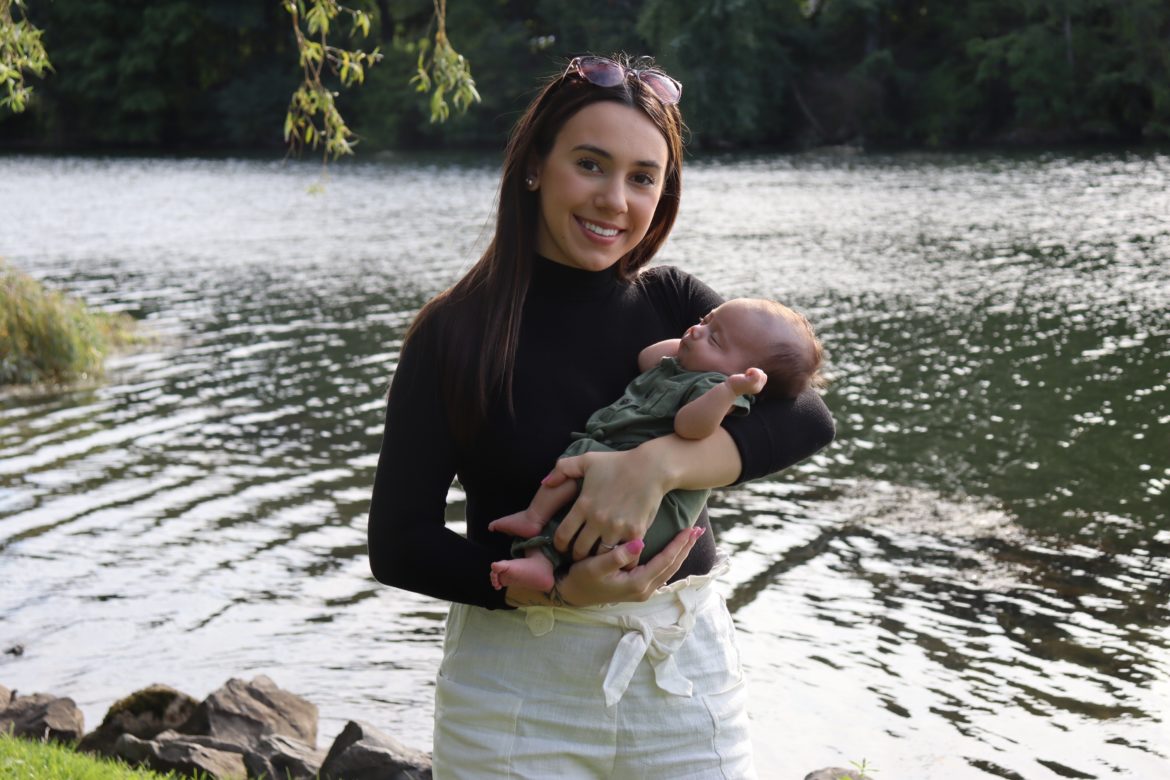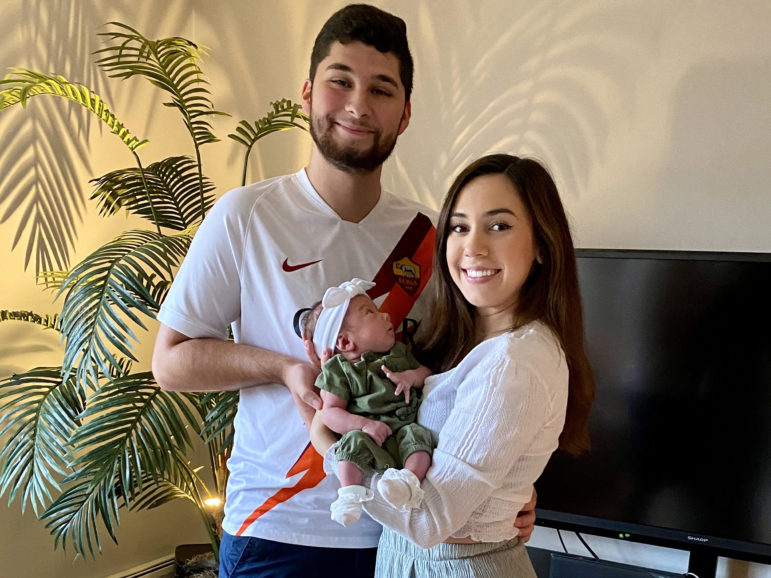By Elizabeth Heubeck

Felicia Tambascio and her daughter, Anastasia Marie Cordero.
Felicia Tambascio’s first pregnancy was going fairly smoothly. But on July 20, at week 38, the 20-year-old Brookfield resident woke with horrible upper abdominal cramps, a searing headache, and vomiting. Her boyfriend took her to the hospital, but Tambascio was left to wait in a hallway alone. Per COVID-19 restrictions, no visitors were allowed unless the patient was admitted to labor and delivery.
After it was discovered that Tambascio was suffering from the life-threatening condition preeclampsia, she was escorted to the labor and delivery ward and induced. “I wanted my mom there so bad,” Tambascio recalled. Pandemic restrictions allowed just one support person during a hospital birth, so the young couple soldiered on alone, greeting their daughter two weeks early. Once moved to the postnatal ward, Tambascio recalled feeling abandoned as she waited upwards of 40 minutes for a nurse to respond to her calls. After three days, Tambascio was discharged—despite her blood pressure remaining elevated, a risk factor for seizures and other related complications in women with preeclampsia. Typically, a patient with preeclampsia would need to demonstrate normal blood pressure levels before being released.
Tambascio’s experience offers a glimpse into how precautions intended to reduce risk of exposure to COVID-19—like limiting external support persons during and after childbirth, offering early discharge, and using telehealth in lieu of in-person postnatal follow-up visits—may unintentionally exacerbate threats to the health outcomes of new mothers and infants in the U.S., which already lag behind those of almost every other developed nation. According to the Commonwealth Fund, the U.S. maternal mortality ratio (deaths/100,000 live births) is 14, compared to 7 in Canada and 4 in Sweden.

Dr. Mary Cooper
Dr. Mary Cooper, the Connecticut Hospital Association’s senior vice president of clinical services, defends area hospitals’ choice to implement procedures designed to reduce the risk of spreading Covid-19. “We have one of the lowest COVID rates in the country right now,” Cooper said.
A Need For Better Support
Maternal health experts say pandemic-related hospital practices like allowing early discharges aren’t necessarily problematic in and of themselves. “Going home at 24 hours [after delivery] can be the right thing for many women. But without close follow-up, it’s not a good model of care,” said Dr. Michelle Telfer, assistant professor of Midwifery & Women’s Health Specialty at Yale School of Nursing.
The lack of postpartum support—minimal in the U.S. even in non-pandemic times compared to that in most other advanced countries—is what’s worrisome, Telfer said. Women in the U.S. typically don’t see their provider until six weeks after childbirth. Contrast that with the United Kingdom, where most women see a midwife for pre- and postpartum care at home at least three times in the first 10 days after delivery, for up to four weeks if necessary. “It’s huge to maintain breastfeeding, and catch complications,” Telfer said.
During the pandemic, some pediatrician and OB-GYN practices have offered expectant and new mothers the option of telehealth visits in place of in-person visits. But it’s unclear if and how telemedicine can capture essential measures of an infant or mother’s health like an accurate blood pressure reading, the presence of an infection or an assessment of mental health.
“There are times when it’s appropriate, and times when you need to be seen,” said Kathy LiVolsi, clinical operations director of maternal-child health at Stamford Hospital, referring to telemedicine visits. “If a newborn is experiencing weight loss, for instance, a doctor needs to lay eyes on the baby.”
Even maternal health professionals need personalized support before, during and after childbirth. “I am a nurse-midwife, and I was overwhelmed” after giving birth, said Dr. Lucinda Canty, an assistant professor of Nursing at the University of Saint Joseph in West Hartford.

Felicia Tambascio, her boyfriend Kevin Cordero, and their daughter, Anastasia Marie Cordero.
Due to COVID restrictions, most, if not all, Connecticut hospitals allow women just one support person with them during labor and delivery, often forcing them to choose, as Tambascio did. Especially for women planning to use a doula for support, this restriction can make a vital difference. Doulas, non-clinical professionals who support mothers during pregnancy, delivery and postpartum, are known to improve birth outcomes.
Seeds of Positive Change
That’s why Canty and other advocates for maternal health are pushing for greater access to doulas. Their services, which typically run anywhere from $2,000 to $5,000, are not covered by most health insurance plans. Subsequently, doulas are out of reach for women who could benefit from them the most. The Doulas for Connecticut Coalition, of which Canty is a member, aims to enhance the professional reputation of doulas statewide by developing a clearly defined scope of their work, ensuring uniform certification through the state, and pushing for reimbursement of their services by all forms of health coverage, including Medicaid.
A related effort seeks to make doulas more accessible to expectant and new mothers of color because, as Yale’s Telfer points out, “poor mortality and morbidity in this country hit Black and brown women at a much higher rate.” In a recent study analyzing readmission rates for new mothers who gave birth in Connecticut hospitals, Black women were twice as likely as white women to be readmitted to the hospital within 30 days of having a vaginal or cesarean delivery; Hispanic women, 40–50 percent more likely.
Telfer supports efforts to close these gaps. She’s a lead consultant for an initiative to expand access to doulas for women in Greater New Haven, particularly Black women at risk for maternal mortality and morbidity. The initiative was launched by New Haven Healthy Start (NHSS), whose efforts over the past few decades have resulted in lowering the disproportionately high death rates of Black infants born there. Earlier this year, NHSS, using grassroots methods, recruited 42 women (incidentally, all women of color) from the surrounding community and trained them free of charge to become doulas for pregnant women in the Greater New Haven area.
Other efforts to improve childbirth outcomes in Connecticut are underway. This fall, the Connecticut Hospital Association will provide infrastructure for the state’s 24 birthing hospitals to join The Alliance for Innovation on Maternal Health (AIM), a national data-driven initiative to improve maternal safety and outcomes by addressing nine “patient safety bundles,” each focusing on a specific maternal health issue, including postpartum depression, hypertension, and hemorrhage, and the reduction of peripartum racial/ethnic disparities.
In the meantime, women giving birth during the pandemic continue to confront a set of restrictions and recommendations intended to mitigate the spread of COVID-19. While some of these may inadvertently threaten to widen cracks in a health care system that bears some responsibility for the nation’s less-than-stellar birth outcomes, at least one pandemic practice is proving to be a positive change.
At Lawrence + Memorial Hospital in New London, for instance, most newborns are staying with their mothers in the hospital rather than in the nursery. The change, begun during the pandemic to minimize unnecessary human contact and possible virus exposure, has had an unexpected upside, said Christine VanVliet, nurse manager of the labor and delivery unit. “I think patients enjoy the family bonding time,” she said. The practice has proven so positive, she said, that the hospital is considering extending it after the pandemic ends.
Support Our Work
The Conn. Health I-Team is dedicated to producing original, responsible, in-depth journalism on key issues of health and safety that affect our readers, and helping them make informed health care choices. As a nonprofit, we rely on donations to help fund our work.Donate Now
Related Stories
- UPDATED: Coronavirus In Connecticut There were no new COVID-19 deaths reported since yesterday, so the death toll remains 4,485. Hospitalizations rose by 7, for a total of 71, the Department of Public Health (DPH) reported. Residents testing positive for the virus total 55,031, an increase of 136 since Monday’s report.
More From C-HIT
- Disparities Industrial Farming Outweighs Willpower In Obesity Crisis, Experts Say
- Environmental Health Industrial Farming Outweighs Willpower In Obesity Crisis, Experts Say
- Fines & Sanctions Medical Board Fines Two Doctors $5,000 Each
- Health Care Health Bills’ Failure A Bitter Pill For Health Care Proponents
- I-Team In-Depth Efforts To Reduce COVID-19’s Spread Could Impact Health Outcomes For New Mothers And Infants

